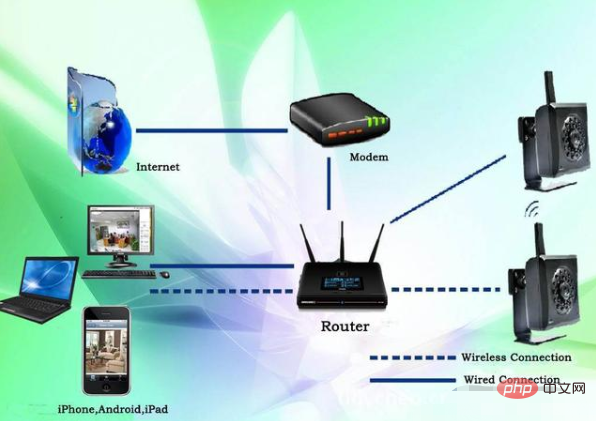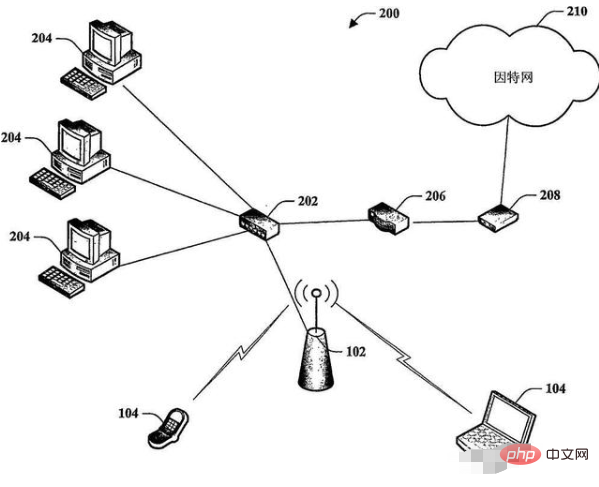What is the difference between unlimited LAN and Wi-Fi?
Difference: Wireless LAN (WLAN) is a general term, which refers to wireless local area network. All network systems that use wireless communication technology to connect computers or other devices to achieve mutual communication and resource sharing belong to WLAN. Wi-Fi is a wireless networking technology that covers different wireless signal ranges.

#The operating environment of this tutorial: Windows 7 system, Dell G3 computer.
What is the difference between unlimited LAN and Wi-Fi?
What is the difference between unlimited LAN and Wi-Fi? In fact, the two have a relationship of inclusion and inclusion. Wireless local area network (WLAN) includes wireless hotspot (Wi-Fi). WLAN is a general term that refers to wireless local area networks. All network systems that use wireless communication technology to connect computers or other devices to achieve mutual communication and resource sharing belong to WLAN, and Wi-Fi is a wireless networking technology.

WLAN is the abbreviation of Wireless Local Area Network. Its essential feature is that it no longer uses traditional cables to connect devices, but uses a more flexible and convenient wireless method, because WLAN has Strong mobility, flexibility and convenience. The use of electromagnetic wave technology to connect communications in space has greatly improved user convenience.

Wi-Fi is essentially a wireless LAN technology based on the IEEE 802.11 standard. It also uses radio waves to access the Internet. Our most common Wi-Fi devices are wireless The router can quickly realize Internet connection sharing in the home wireless network through the router's built-in DHCP client, Network Address Translation (NAT) and other functions. All devices under the same Wi-Fi actually form a wireless LAN.
Wi-Fi can be said to be the most widely used wireless network transmission technology at this stage. Almost all Internet-connected devices such as mobile phones and tablets support this technology. Wi-Fi technology can be simply understood as converting wired network signals into wireless network signals, so that devices can be interconnected through wireless wires. The biggest advantage is that there is no need to connect devices through cables, and the transmission power is low, making it very suitable for office use. and family environment.
Because Wi-Fi is a technology included in WLAN, it can be said that WLAN has a wide range of applications, ranging from homes to enterprises to metropolitan area networks. Home wireless WLAN can be regarded as the simplest application. Devices access Internet resources through wireless hotspots generated by routers. It also allows enterprises to establish cross-building WLAN networks in multiple buildings through bridging.
WLAN can use two or more components of the device to be combined to form a multi-level, wireless and wired computer network. Wi-Fi actually provides a way to interconnect various terminals using wireless connections, while shielding users from the differences between various devices.
The difference between wireless LAN and Wi-Fi
1. WiFi is included in wireless LAN, with different power of transmitting signals and different coverage areas
In fact, WIFI is a trademark of WL ANA (Wireless LAN Alliance). This trademark only guarantees that products using this trademark can cooperate with each other. It has nothing to do with the standard itself. However, because WIFI mainly uses the 802.11b protocol, people gradually It is customary to use WIF to refer to the 802.11b protocol.
In terms of inclusion relationship, WIFI is a standard of WLAN. WIFI is included in WLAN and is a new technology that adopts WLAN protocol. The coverage range of WiFi can reach about 300 feet (about 90 meters), and the maximum WLAN (with antenna) can reach 5KM.
2. The covered wireless signal range is different
WIFI (Wireless Fidelity), also known as the 802.11b standard, its biggest advantage is its high transmission speed, which can reach 11Mbps, and its effective distance It is also very long and compatible with various existing 802.11DSSS devices. Wireless Internet access has become a reality.
Radio waves have a wide coverage range. The coverage range of radio waves based on Bluetooth technology is very small, with a diameter of only about 50 feet or 15 meters, while the radius of Wi-Fi can reach about 300 feet or 90 meters. . However, with the development of wifi technology, wifi signals will cover a wider range in the future.
If you want to read more related articles, please visit PHP Chinese website! !
The above is the detailed content of What is the difference between unlimited LAN and Wi-Fi?. For more information, please follow other related articles on the PHP Chinese website!

Hot AI Tools

Undresser.AI Undress
AI-powered app for creating realistic nude photos

AI Clothes Remover
Online AI tool for removing clothes from photos.

Undress AI Tool
Undress images for free

Clothoff.io
AI clothes remover

Video Face Swap
Swap faces in any video effortlessly with our completely free AI face swap tool!

Hot Article

Hot Tools

Notepad++7.3.1
Easy-to-use and free code editor

SublimeText3 Chinese version
Chinese version, very easy to use

Zend Studio 13.0.1
Powerful PHP integrated development environment

Dreamweaver CS6
Visual web development tools

SublimeText3 Mac version
God-level code editing software (SublimeText3)

Hot Topics
 1386
1386
 52
52
 Wi-Fi does not have a valid IP configuration: How to fix it
Apr 13, 2023 pm 06:22 PM
Wi-Fi does not have a valid IP configuration: How to fix it
Apr 13, 2023 pm 06:22 PM
Restart your computer and router you know what to do; if you call your ISP technical support, they will ask you to restart your network hardware. This is for good reason, as restarting your PC will clear out running applications and caches that may be conflicting with your connection. Restarting (rebounding) your router (usually a combo unit containing a router and modem) will clear its cache and re-establish a reliable online connection. If you have a separate modem, restart that as well. Restart the router by unplugging the power button for 30 seconds and then plugging it back in. After powering up the router, restart your PC and see if you regain a stable Wi-Fi connection. Re-enable Wi-
 Top 5 Ways to Find Your Mac's Address on iPhone Using the Settings App or Router
Apr 13, 2023 pm 05:46 PM
Top 5 Ways to Find Your Mac's Address on iPhone Using the Settings App or Router
Apr 13, 2023 pm 05:46 PM
Any device connected to the Internet has two types of addresses - a physical address and an Internet address. While Internet addresses locate devices globally, physical addresses help identify specific devices connected to a local network. This physical address is technically called a MAC address, and if you're wondering if your iPhone has one, yes, all phones (including iPhones) have their own unique MAC address. What is a MAC address? The Media Access Control or MAC address is a unique indicator used to identify your device from other devices connected to the same network. If you have a device that can connect to the internet, it will register a MAC address. This address is owned by
![How to Fix Wi-Fi Privacy Warning on iPhone [Solved]](https://img.php.cn/upload/article/000/465/014/168173412260805.png?x-oss-process=image/resize,m_fill,h_207,w_330) How to Fix Wi-Fi Privacy Warning on iPhone [Solved]
Apr 17, 2023 pm 08:22 PM
How to Fix Wi-Fi Privacy Warning on iPhone [Solved]
Apr 17, 2023 pm 08:22 PM
Apple has always taken significant measures to ensure that its users have the best experience and have maximum privacy and security for their data. Despite this assurance, many iPhone users have reported this issue where they receive privacy warning messages on their iPhones under connected Wi-Fi networks. Since iPhone users receive this privacy warning, they are very insecure and afraid to use Wi-Fi networks on their iPhone. This could be due to internal technical glitches, changes to network settings, disabling privacy settings on the Wi-Fi network, etc. In this article, we will explain how to easily solve this problem using different techniques. Fix 1 – Turn on Private Wi-Fi address option for Wi-Fi network Step 1: Click on Settings
 ZTE 5G portable Wi-Fi U50S goes on sale for NT$899 at first launch: top speed 500Mbps
Apr 26, 2024 pm 03:46 PM
ZTE 5G portable Wi-Fi U50S goes on sale for NT$899 at first launch: top speed 500Mbps
Apr 26, 2024 pm 03:46 PM
According to news on April 26, ZTE’s 5G portable Wi-Fi U50S is now officially on sale, starting at 899 yuan. In terms of appearance design, ZTE U50S Portable Wi-Fi is simple and stylish, easy to hold and pack. Its size is 159/73/18mm and is easy to carry, allowing you to enjoy 5G high-speed network anytime and anywhere, achieving an unimpeded mobile office and entertainment experience. ZTE 5G portable Wi-Fi U50S supports the advanced Wi-Fi 6 protocol with a peak rate of up to 1800Mbps. It relies on the Snapdragon X55 high-performance 5G platform to provide users with an extremely fast network experience. Not only does it support the 5G dual-mode SA+NSA network environment and Sub-6GHz frequency band, the measured network speed can even reach an astonishing 500Mbps, which is easily satisfactory.
 How to open Wi-Fi settings in Windows 11
Apr 13, 2023 pm 02:37 PM
How to open Wi-Fi settings in Windows 11
Apr 13, 2023 pm 02:37 PM
The Windows WiFi settings window provides its users with many WiFi settings options. Some of the settings available in the WiFi settings window are as follows. Turn WiFi on or off View and edit the properties of the current network Display available network management Known networks View and manage Wi-Fi adapter properties Troubleshoot network connection issues Therefore, the WiFi Settings window is a primary window as it provides all the major WiFi configurations options. If you are working on a network-related project, or you are a student who is looking into WiFi management settings, or someone who needs to open the WiFi settings window very frequently for other reasons, you may be happy to know that there are many options for you to open WiF
 10 Ways to Pair iPhone with Macbook
Apr 18, 2023 pm 01:01 PM
10 Ways to Pair iPhone with Macbook
Apr 18, 2023 pm 01:01 PM
Apple's suite of products like the iPhone, iPad, Mac, and Watch have always been considered the next generation and leaders in their respective fields, but if there's one thing that makes them better, it's making them good an “ecosystem” that is interconnected. This ecosystem combines most of the apps and features people use on their devices into a unified experience that works together and behaves similarly no matter which device you choose. As a result, an app, website, or service will look and feel the same on your iPhone, iPad, or Mac. If you own multiple Apple devices, you can expect it to work with other devices, e.g. if you don't
 3 easy ways to change your Wi-Fi password on Windows 11
May 17, 2023 pm 11:53 PM
3 easy ways to change your Wi-Fi password on Windows 11
May 17, 2023 pm 11:53 PM
Are you unable to access the internet because of a wrong Wi-Fi password? Maybe you want to change your Wi-Fi password on Windows 11 but aren't sure how. This is a common problem that many people face when they don’t know how to change network settings. A good password is essential for security. If a malicious person obtains your password, he/she can use it to access your personal information such as email, bank account details, and other sensitive information. Changing your Wi-Fi network's password can be a critical step in securing your home network. Whatever the reason, changing your Wi-Fi network password is easy and only takes a few minutes. How to check Wi-Fi password in Windows 11?
![How to Fix iPhone WiFi Keeps Disconnecting Repeatedly [Solved]](https://img.php.cn/upload/article/000/887/227/168456214865307.png?x-oss-process=image/resize,m_fill,h_207,w_330) How to Fix iPhone WiFi Keeps Disconnecting Repeatedly [Solved]
May 20, 2023 pm 01:55 PM
How to Fix iPhone WiFi Keeps Disconnecting Repeatedly [Solved]
May 20, 2023 pm 01:55 PM
Many iPhone users have expressed disappointment with one of the serious issues they face on their iPhone. The problem is that their iPhone disconnects from Wi-Fi every now and then. This is indeed a major issue since Wi-Fi is a necessity to use most apps on your iPhone. We have thoroughly analyzed this issue and identified the factors that may be responsible and listed them below. Auto-join settings are disabled Some issues in network settings Change Wi-Fi password Changed Wi-Fi router issues After looking into these factors mentioned above, we have compiled a set of solutions that can fix disconnection issues with Wi-Fi issues iPhone. Fix 1 – Turn on Wi-Fi’s auto-join setting if Wi-Fi is not enabled



